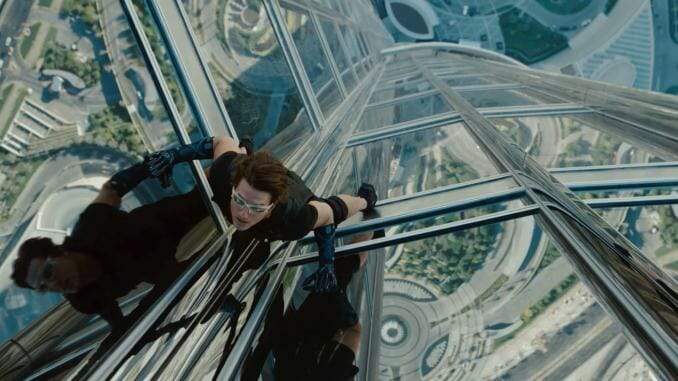How Mission: Impossible – Ghost Protocol‘s Humor Helped Save the Franchise 10 Years Ago

In a cinematic landscape where superheroes rule the box office, the kind of high-flying action/espionage franchises that were once a dime a dozen in the ‘90s and early 2000s have slowly begun to fade from the public consciousness. Sure, Hollywood still continues to churn out one-off action star vehicles and sci-fi epics, but true action-spy franchises are becoming a dying breed: Except for Mission: Impossible. Where so many of the franchise’s contemporaries—like Fast and the Furious’ endless parade of increasingly Ludacris heist-related sequels, or the lackluster late Pierce Brosnan Bond films—have struggled to remain fresh and engaging as audience expectations for visual effects soar higher and interest in non-superhero action flicks continues to decline, Mission: Impossible is one of the few spy franchises to thrive. Though most look to Christopher McQuarrie’s Mission entries as the best the franchise has to offer, it was Brad Bird’s Mission: Impossible – Ghost Protocol—which celebrates its 10th anniversary this week—that paved the way for the franchise’s continued success and reinvention: A lighthearted, self-aware fourth installment that infuses comedy with character to create a fresh, memorable film.
When most folks think “Mission: Impossible”, there are a few particular trademarks that come to mind: Tom Cruise and his notorious commitment to stunt work, self-destructing mission briefs, Lalo Schifrin’s iconic theme. But even with the franchise’s recognizable and well-loved elements, when the Mission: Impossible films were coming up on their fourth installment, it was clear that something had to give: The tried-and-true formula that had helped the franchise find early success was growing stale.
Despite box office success and a compelling lead, the franchise’s by-the-numbers approach to filmmaking and the less-than-dazzling supporting characters made for an initial trilogy that, though certainly watchable, lacked the necessary spark to ensure franchise longevity. Though each early franchise entry was helmed by a different director, none quite managed to forge a new, memorable identity for the franchise: De Palma’s first outing certainly had charm, but felt more like an adaption of the series than an attempt to establish a new cinematic universe that could stand on its own two feet. John Woo’s Mission: Impossible 2 (with the exception of Thandie Newton’s femme fatale) serves as an utterly unremarkable entry—from the cliched plot to its empty stunts. Mission: Impossible changed hands yet again with J.J. Abrams’ feature directorial debut Mission: Impossible III, which went heavy on the plot twists and backstory for Ethan, but still lacked the pulse-pounding spark and gleeful magic that makes the heist in the first film so beloved.
The twist-filled Mission: Impossible films were becoming ironically and unfortunately predictable, their old-school style being passed over in favor of grimmer blockbusters like The Dark Knight, Inception and the Bourne franchise. Even the Bond films had recognized the need to evolve, releasing the grittier, wittier Casino Royale to massive critical acclaim. Compared to their sharp, dark scripts and inventive action sequences, Mission: Impossible felt like a reliable but outdated remainder in need of an upgrade— but with roots in a cheesy ‘60s TV show, trying to follow suit and transform Mission: Impossible into a similarly serious action franchise would be a fool’s errand. So, going against the grain, Mission: Impossible took the opposite route—opting to take itself less seriously, infusing its films with humor, and enlisting a secret weapon to help bring Ghost Protocol to life: Director Brad Bird.
At the time, Bird was hardly the no-brainer choice to spearhead one of Hollywood’s most famous action/spy franchises. He’d only directed animated films—The Incredibles, The Iron Giant and Ratatouille, to name a few. As it turned out, though, an unorthodox choice of director was exactly what the franchise needed. J.J. Abrams, whose aforementioned entry was his first film after finding success in shows like Lost and Alias was the franchise’s first attempt at filling this void, but though his penchant for narrative twists and choice to introduce Ethan’s wife Julia would prove apt, his lack of blockbuster experience meant the action sequences—the one thing moviegoers had always come to expect from a Mission: Impossible movie—fell flat. With Bird, though, his unorthodox background in comedy-infused animated films helped bring some much-needed levity to Mission: Impossible, making it stand out from its self-serious contemporaries.
-

-

-

-

-

-

-

-

-

-

-

-

-

-

-

-

-

-

-

-

-

-

-

-

-

-

-

-

-

-

-

-

-

-

-

-

-

-

-

-








































